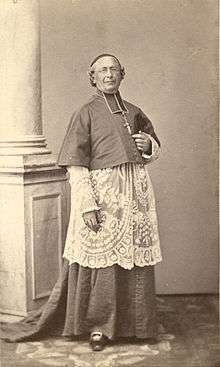Célestine Guynemer de la Hailandière
| Célestine Guynemer de la Hailandière | |
|---|---|
|
Bishop of Vincennes (1839–1847) | |
 | |
| Orders | |
| Ordination | May 28, 1825 |
| Consecration |
August 18, 1839 by Charles Forbin-Janson |
| Personal details | |
| Born |
May 3, 1798 Combourg, France |
| Died | May 1, 1882 (aged 83) |
| Buried | Vincennes, Indiana |
| Styles of Célestine Guynemer de la Hailandière | |
|---|---|
.svg.png) | |
| Reference style | The Right Reverend |
| Spoken style | Your Excellency |
| Religious style | Bishop |
| Posthumous style | none |
Célestine René Laurent Guynemer de la Hailandière (May 3, 1798 – May 1, 1882) was a French-born American prelate of the Roman Catholic Church. He served as Bishop of Vincennes, (now the Archdiocese of Indianapolis), from 1839 to 1847.
Biography
Early life
Hailandière was born May 3, 1798 in Combourg during the time of the French Revolution. He was baptized the same day by a priest sheltered in hiding in his father's house. The family later moved to Rennes, where Hailandière began his classical studies. At the age of nineteen he took up the study of law, and was admitted to the bar. In 1822, after attending a mission, he decided to become a priest. Counseling against making a rash decision, his father encouraged him not to give up the law, and through an acquaintance with Jacques-Joseph Corbière had young Hailandière appointed judge of the civil tribunal of Redon at the age of twenty-four.[1]
After a brief time as judge, he resigned the position and in October 1822 entered the seminary at Rennes. From there he went to the Seminary of Saint-Sulpice in Paris. Apart from his studies, he was assigned to teach catechism under the direction of Félix Dupanloup, later Bishop of Orleans. Hailandière was ordained a priest on May 28, 1825 in Paris and assigned as curate of the parish of St. Germain in Rennes.[1] In 1836 Simon Bruté, Bishop of Vincennes came to Rennes looking for an assistant who could serve as his vicar-general. The Bishop of Rennes recommended the curate of St. Germain, and Hailandière left for the United States with Bruté.[2]
The diocese, which included the state of Indiana and the eastern part of Illiois, was sparcely populated with only a few small towns and widely scattered farms. The Potawatomi and Miami lived in the northern part of Indiana. There were few Catholics.[1]
Bishop
On May 17, 1839, Hailandière was appointed Coadjutor Bishop of Vincennes and Titular Bishop of Axieri by Pope Gregory XVI. At the time, he was the youngest bishop in the United States. Bishop Bruté sent Hailandière as a representative to their native France to raise funds, recruit priests, and invite religious congregations to come to the diocese and teach, provide religious instruction, and assist the sick. The Sisters of Providence of Ruillé-sur-Loir agreed to send some sisters, among whom was Théodore Guérin.[3] Bishop Bruté died on June 26, 1839, while Hailandière was in France.
Hailandière succeeded Bishop Bruté as the second Bishop of Vincennes on the following June 26, and received his episcopal consecration in Paris on August 18 from Bishop Charles Forbin-Janson, with Bishops Louis Blanquart de Bailleuil and Jean-Louis-Simon Lemercier of Beauvais serving as co-consecrators.[2] In 1840 Hailandière attended the Fourth Provincial Council in Baltimore.[4]
In 1842, Bishop Hailandière, offered land to Father Edward Sorin of the Congregation of Holy Cross, on condition that he build a college in two years.[5] Fr. Sorin arrived on the site with eight Holy Cross brothers from France and Ireland on November 26, 1842, and began the school using Father Stephen Badin's old log chapel.[6] Thus began the University of Notre Dame.
During his tenure, the eastern third of Illinois, which had hitherto been part of the diocese's territory, was separated from the Diocese of Vincennes upon the establishment of the Diocese of Chicago on November 28, 1843. Whether the Bishop was a perfectionist, not clear in his instructions, or lacked confidence in his subordinates, Hailandière had difficulty delegating work and so had trouble keeping assistants.[3] Hailandière resigned his post on July 16, 1847, after eight years of service, and then returned to France.[2] He was succeeded by John Stephen Bazin.
Death
Bishop de la Hailandiere died at the family estate at Triandin, near Combourg on May 1, 1882 (two days before his 84th birthday), 35 years after his return to France. At his request, his remains were returned to the United States in November 1882[7] and were transferred to and buried in the Old Cathedral of Vincennes on November 22, 1882.[3]
References
- 1 2 3 Audran, E., Address on the occasion of a solemn mass for Bishop Hailandière, Jefferson, Indiana, July 7, 1882

- 1 2 3 "Right Rev. Célestin René Laurent Guynemer de la Hailandière", Archdiocese of Indianapolis
- 1 2 3 Blanchard, Charles. History of the Catholic Church in Indiana, Chapter IV, "Administration of Bishop Hailandière", A. W. Bowen & Company, 1898

- ↑ Shea, John Gilmary. History of the Catholic Church in the United States, McBride, 1890, p. 653

- ↑ "Edward Sorin and the Founding of Notre Dame", University of Notre Dame Archives, February 6, 2014
- ↑ "Notre Dame – Foundations: 1.2". Archives.nd.edu.
- ↑ New York Times article on the arrival of his remains
External links
| Wikimedia Commons has media related to Célestine Guynemer de la Hailandière. |
Episcopal succession
| Catholic Church titles | ||
|---|---|---|
| Preceded by Simon Bruté de Rémur |
Bishop of Vincennes 1839–1847 |
Succeeded by Jean Bazin |
